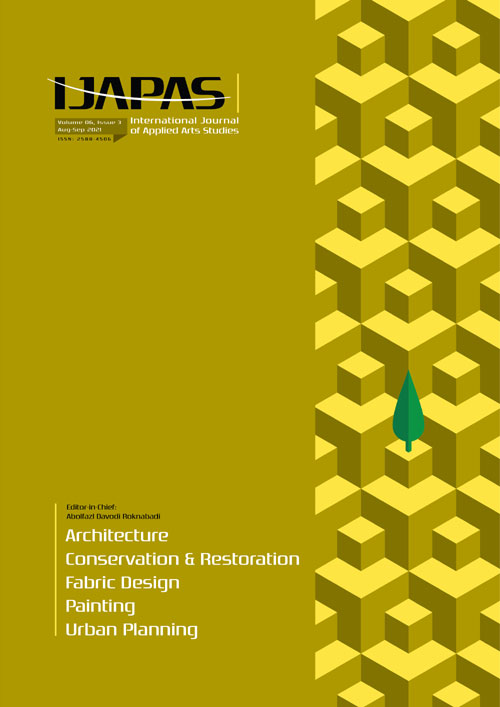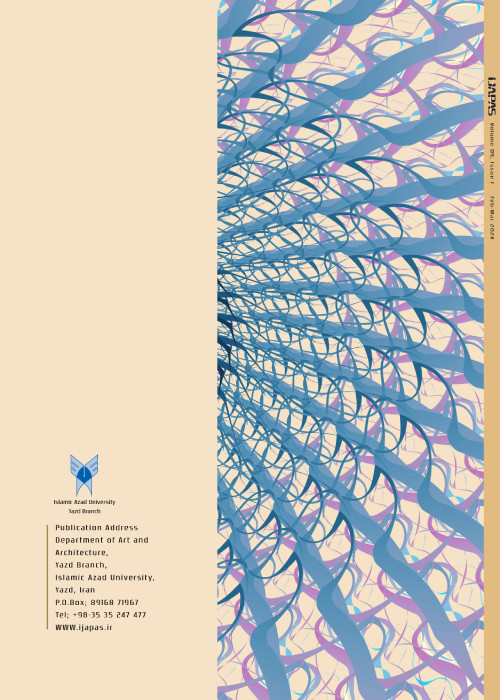فهرست مطالب

International Journal of Applied Arts Studies
Volume:6 Issue: 2, May-Jun 2021
- تاریخ انتشار: 1400/09/16
- تعداد عناوین: 6
-
Pages 7-25
The innate tendency of humans towards nature has made them pay specific attention to this issue in different fields, and particularly architecture. This study was conducted to recognize common components of biophilic architecture and local architecture and analyze their impacts on helping designing something with sustainable local identity. As the local identity of an architectural work can play a key role in creating new works, emphasizing common components of local and biophilic design can help not only the sustainability of work but also the physical and mental health of individuals. In this applied research, research questions were answered using architectural design models in combination withbiophilic design components affecting space localization. Data collection was done using the library method, field observations, and using a questionnaire. After analysis of the questionnaires, common components of local and biophilic architectures were introduced. Then, the data were measured in Shiraz Enghelab Bazaar as a sample business center the results showed that in terms of the effect of all common components of local and biophilic architecture on the local identity of a business center, three components including nature-environment harmony, natural facilities of the environment, and climatic conditions had the most effect on the sustainable local identity of a business center respectively.
Keywords: Local Identity, Business Centers, Biophilic Design, Shiraz Enghelab Bazaar -
Pages 27-43
Tall buildings, according to the progress of human societies are increasing dramatically in different parts of the world. The point that distinguishesa high-rise building from the other ones is the prominent role of structure in the tower design. So, the structure in the design process and architectural final design not only heading its main task, means bearing and transmission forces, but also accepts other roles to cover other design criteria including aesthetics, energy and etc. The reason for combination of these roles is in a high-rise building due to the reduction of the weight of the building in order to bear lateraland gravity forces, structure must acceptmultiple roles to reduce additional elements. In thispaper, by studying effective measures in designing of tall buildings andidentifying the characteristics of each one, suggestions are offered towards appropriate integration of these measures in order to design a high-rise building. These suggestions can help architects at the beginning of the way of designing a tower. In fact, considering these measures lead to create options that other design teams (like structural team) will not face the great problems in the rest of the way.
Keywords: High-rise Buildings, Design Criteria, Structure, Aesthetics, Energy, Urban Design, Skyline, Design Process -
Pages 45-54
The purpose of this research is to determine the effect of teaching color knowledge on student’s educational success in visual arts’ course in private schools and governmental ones –affiliated with technical-vocational colleges. The objective is not only to increase efficiency in educational activities, but also, would be a framework for other educational activities.The 11thgradestudents from technical-vocational high schools in Tehran was selected as the case study. The color knowledge of visual arts course was the subject instructed for this population through two different methods; one as experimental group, another as control group, which both was selected at random. The color knowledge taught with the materials supports in experimental group, and through classical method in control group. In order to determine the effect of teaching methods in students' academic achievement, Pre and post testing designed for thecontrol group. As a result of applied tests on the experimental and control group before and after teaching the subject.It was found that the success of the experimental group using materials, was greater than the control group taught through classical method. Therefore, it was found that teaching the subject of "color knowledge" using materials contributes to students' academic success.
Keywords: Art Education, Color Knowledge, Visual Arts, Visual Design -
Pages 55-63
Contemporary paintings are abundantly brought up withcombination of various images ofIranian Gardens in order to describe identity and culture of Iran,because these paintings have important role in retrieving and recognizingIranian identity,culture and history,and also have a very long-lasting record, because of which there exists a need forstudying. Contemporary paintings,all inherited from Iranian Gardendesign,embed presentation of plans,animals and architecture,asmatters ofidentity and culture of our country, canhelp to makebetter recognition and revival of pastculture and older Iranian identity.Gardenshave hadvery important place since old days in Iranian culture and civilizationand havebeen counted as oneofthefundamental concepts of social, cultural and naturaldiscourse of thisland.Still presentedin Iranian literature,architecture andpainting in different forms,in a way that these days’painters pay special attentionto outcome conceptsofIranian Gardens. The main purpose of this work is recognizing andretrievingthe concepts of Iraniangarden in content of contemporary Iranian painting. At the time being, study conclusions show that it is possible to retrieve the concepts of the Iranian garden by means of analyzing and demonstrating the content of landscape drawing drawn by contemporarypainters,especiallyconstruction type, rhythm, symmetry, and coloring used in these works.
Keywords: Garden, Iranian Garden Pattern, Contemporary Painting -
Pages 65-69
In this research, insect repellent fabric (bee) was produced and with this fabricthe beekeepers' clothes were designed.Therefore, a fabric has been designed and produced so that the bee does not come in connect with the beekeeper from a distance so that it cannot bite. In the theoretical section of this article, initially, types of fabrics were examined. After selecting the type of fabric that should have the cooling property, the different types of beekeepers' clothes were studied.In this regard, research and studyhas been done on the repellents that can be used in this article. Then, the process of practical work and production ofrepellent fabrics was done and the repellent fabrics were produced by using diethyltoluamide in combination with the fabric.Finally, with the findings obtained regardingthe efficiency and use of the relevant clothing, the initial plans related to them wereperformed, and after the approval of the final designs, the Marulus program was used to implement them.Also,the design execution was analyzed.
Keywords: Beekeepers’Clothes, Fabric Design, Insect Repellent -
Pages 71-80
There are two major Hellenic and Oriental tendencies in party art. In addition, the gradual transformation of Greek thought under the influence of the East can be discerned. Sassanid art is a sign of ethnic effort and taste, whose culture and art follow the Achaemenid and Parthian art. This art embodies the principles of Iranian aesthetics, which inherits the arts of early Asia. Making Rhytonis one of the most interesting and valuable examples of Iranian art and expresses the creative spirit and inherent genius of Iranians. Rhytonsare animal drinking vessels, some with one mouth and some with two or more openings for liquids to enter and leave, used for drinking liquids at banquets, court ceremonies, and ceremonies. Drinking from such cups has symbolicallymeant the transfer of living vital force to man. By examiningthe achievements of the ancient Iranians, the possibility of recognizing and understanding their mental concepts as well as the type of social and cultural life of the societies of that time becomes clear to us. Based on this, it was decided to study the unique form, role and composition of a small number of Rhytonsof the Parthian and Sassanid periods. The early Parthian rites were influenced by Greek and Hellenic culture, but gradually the national tendencies of the Iranian tribes emerged in them, while the early Sassanid rites were influenced by the Achaemenids, but the influence of Parthian and Roman art can’tbe denied.
Keywords: Rhyton, Sassanid, Parthian, Form, Shape


